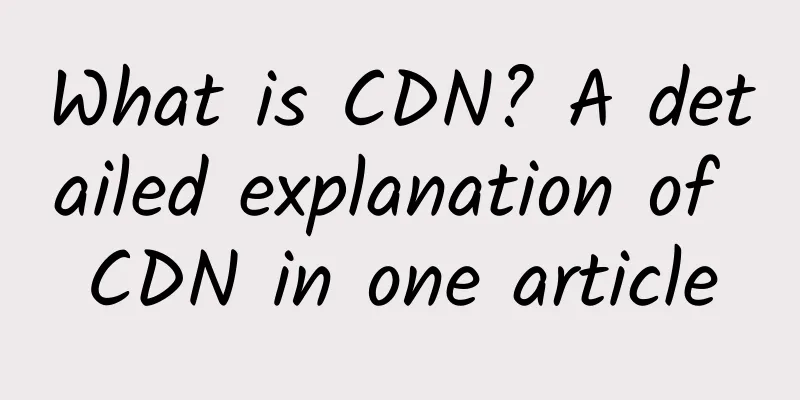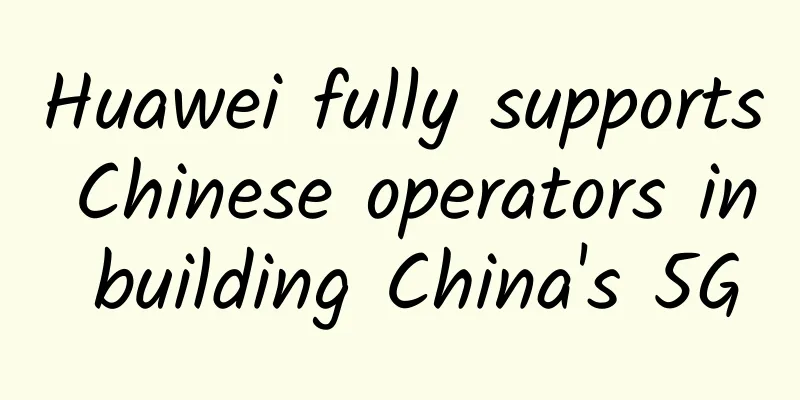What is CDN? A detailed explanation of CDN in one article

|
In today's mobile Internet era, more and more people use their mobile phones to watch videos and enrich their entertainment life.
However, when you are watching TV series, have you ever thought about a question - why sometimes your mobile phone's Internet speed is very fast, but when you watch the video, it still freezes? Before answering this question, let's do a math problem. Take the previously popular "Story of Yanxi Palace" as an example. At that time, it achieved 10 million users watching online at the same time on a certain video APP. If everyone is watching a 1080p video (which theoretically requires 4Mbps bandwidth), then the cumulative traffic bandwidth required is 10,000,000×4Mbps=40,000,000Mbps=40Tbps. For Internet video content providers such as Youku and iQiyi, this is undoubtedly a huge traffic pressure. The network card of our ordinary computer has a bandwidth of 1Gbps. If Youku has a super server, then this super server needs 40,000 network cards, and they must run at 100% full speed to enable smooth viewing for these 10 million users. For some service providers that are not strong enough, or when there is a sudden surge in traffic, congestion will occur, resulting in freezes and delays. There is such a saying: When a user opens a page and waits for more than 4 seconds, he will close the page, which means that the user will be lost. ▼This should be the symbol that everyone hates the most The loss of users means the loss of money. No Internet service provider wants this to happen. Therefore, they must find ways to present their content as quickly as possible, shorten the user's waiting time, and improve the user experience. CDN is a very effective technology for shortening latency. The Birth of CDN In the 1980s, Internet technology had just entered the civilian field. People mainly access the Internet through dial-up, the bandwidth is very low, and there are few users, so there is no pressure on the backbone network and servers. With the explosive development of the Internet, the number of users is increasing, and with the emergence of broadband access networks, the pressure on content source servers and backbone networks is increasing, and they are unable to respond to users' access needs in a timely manner. In 1995, Dr. Tim Berners-Lee, a professor at MIT and one of the inventors of the Internet, discovered that network congestion was becoming increasingly serious and would become the biggest obstacle to the development of the Internet.
So he raised an academic problem, hoping that someone could invent a completely new method that would fundamentally solve the problem and achieve congestion-free distribution of Internet content. Next to Dr. Tim Berners-Lee was Professor Tom Leighton's office, a professor of applied mathematics at MIT.
Tom Leighton Intrigued by Berners-Lee's challenge, he asked graduate student Danny C. Lewin and several other top researchers to work together to crack this technical problem.
Danny C. Lewin Finally, they developed a dynamic routing algorithm technology that uses mathematical algorithms to process content, effectively solving this problem. This technology is CDN. They even set up a company specifically for this purpose to bring out its commercial value. This company is the famous CDN service originator - Akamai. How CDN Works The CDN technology is actually not complicated. The original core concept is to cache content near the end users. Isn't the content source far away? Then, we can build a cache server close to the user, copy the remote content and put it here, isn't that OK? Because this technology distributes content, it is called CDN - Content Delivery Network. Specifically, CDN uses more cache servers (CDN edge nodes) and deploys them in areas or networks where user access is relatively concentrated. When a user visits a website, the global load technology is used to direct the user's access to the nearest cache server, which responds to the user's request. (It's a bit like an e-commerce local warehouse, right?) You may think that this is just a "mirror server"? In fact, it is different. A mirror server is a complete copy of the source content server. CDN, on the other hand, is a cache of some content and is more intelligent. To be precise, CDN = smarter mirroring + caching + traffic diversion. It should also be noted that CDN is not only capable of caching video content, it can also distribute static resources of websites (such as various types of images, HTML, CSS, JS, etc.) and static content of mobile applications (such as installation package apk files, images and videos in the APP, etc.). Let's take an example to see the specific workflow of CDN. If a user wants to access Youku's video-on-demand content, then: Specific steps: ①. When the user clicks on the content on the APP, the APP will go to the local DNS (Domain Name System) to seek IP address resolution based on the URL address. ②. The local DNS system will hand over the domain name resolution rights to the CDN dedicated DNS server. ③. CDN dedicated DNS server returns the IP address of CDN's global load balancing device to the user. ④. The user initiates a content URL access request to the CDN's load balancing device. ⑤. The CDN load balancing device selects a cache server in the user's area based on the user's IP address and the content URL requested by the user. ⑥The load balancing device tells the user the IP address of the cache server and allows the user to initiate a request to the selected cache server. ⑦. The user initiates a request to the cache server, and the cache server responds to the user's request and transmits the content required by the user to the user terminal. ⑧. If the cache server does not have the content the user wants, then the cache server will request the content from the website's source server. ⑨. The source server returns the content to the cache server, which sends it to the user and determines whether to cache the content on the cache server based on the user's customized cache policy. Benefits of CDN The biggest benefit of using CDN technology is that it speeds up website access - the physical distance between users and content is shortened, and users' waiting time is also shortened. Moreover, cache servers distributed to different lines also accelerate access across operators. For example, when China Mobile users access content sources on China Telecom's network, they can accelerate the process by setting up a CDN server on China Mobile. The effect is very obvious. In addition, CDN also has security benefits. After the content is distributed, the IP address of the source server is hidden, and the probability of being attacked is greatly reduced. Moreover, when a server fails, the system will call a nearby healthy server to provide services to avoid affecting users. Because CDN has many benefits, all major Internet service providers currently use CDN technology. All cloud service providers also provide CDN services (the price is not expensive and is charged by traffic). CDN and the communications industry CDN is a service developed from the traditional IT industry. However, for our communications industry, CDN also has great commercial value. Internet service providers use CDN to trade storage for latency, spending money to purchase CDN servers or cloud computing services in exchange for a better user experience. Communication operators are also chasing after CDN, but their purpose is to exchange storage for bandwidth - by "sinking" services, they can reduce the traffic pressure on the upper backbone network, avoid hardware expansion, and reduce network construction costs. This is easy to understand. If a large amount of business traffic data runs back and forth in the backbone network, the backbone network will definitely not be able to handle it and will have to desperately expand its capacity. If these business traffic data are solved at the bottom layer, then the bandwidth pressure of the backbone network will naturally be reduced. Isn't it? Many operators have already moved CDN down to the city level to reduce pressure and improve user experience. At this point, have the majority of communication Wangs thought of anything? That’s right, this is similar to the mobile edge computing introduced a few days ago. As network capabilities continue to improve, content resources and computing power have been moving up to cloud computing centers. A core cloud computing center provides services to all terminal nodes.
As a result, people looked back and discovered that for very large areas and a large number of users, especially national or world-class services, no matter where you set up the center or how powerful the center is, it cannot overcome the barriers of physical distance, which will lead to unbearable delays and network congestion. As a result, people began to partially "sink" cloud computing centers, which led to fog computing and haze computing. People even began to question whether centralized computing would eventually be replaced by distributed computing.
Blockchain is the representative of distributed computing In Xiaozaojun's opinion, there is no question of who will completely replace whom. Different scenarios bring different needs, and different needs require different network architectures. Diversification of scenarios is a reality, so the flexibility of network architecture is also an inevitable choice. The upcoming 5G proposes three major scenarios and slices, using the same network to meet different needs, which embodies this design concept and conforms to the development direction of the trend. In short, for network technology, no matter whether the cat is black or white, as long as it can catch mice, it is a good cat. Isn't it? |
<<: Talk about TCP long connection and heartbeat
>>: Two questions to easily understand Riverbed's 2018 and 2019
Recommend
Lenovo Huang Ying: 6G will be a "super channel" connecting the virtual and real worlds under full intelligent applications
On June 28, the MWC Shanghai World Mobile Communi...
10gbiz: 50% off, starting from $3.44/month, Hong Kong CN2 GIA/Los Angeles CN2 GIA/AS9929/large hard disk VPS optional
10gbiz is offering a 50% discount on all VPS host...
edgeNAT Mid-Autumn Festival Promotion: 20% off for monthly VPS and 30% off for annual VPS, Hong Kong CN2/Korea CN2/US CUVIP optional
edgeNAT has sent out promotions for the Mid-Autum...
From 76 million 5G connections, we found the 7 most promising 5G IoT applications
5G is the fifth generation of mobile communicatio...
The American Internet is about to undergo a major change: Is the protective umbrella Section 230 really going to disappear?
"Revoke 230!" US President Trump wrote ...
"5G+Industrial Internet" security capabilities and scenario-based solutions
[[417951]] Under the wave of the new generation o...
Huawei and Standard Chartered Bank collaborate to create IoT solutions to expand trade finance ecosystem
October 10, 2018 Shanghai - Huawei and Standard C...
New radio regulations promote the development of multiple industries including 5G, Beidou, civil aviation, etc.
[[177681]] On November 28, the Ministry of Indust...
8 trends in infrastructure development in 2018
Cloud computing is gradually gaining favor among ...
From edge to 5G, Inspur’s battle for the beachhead
The word "edge" suddenly became extreme...
Tencent Cloud New Year Special Offer: 2C2G4M Cloud Server 30 Yuan/3 Months or 108 Yuan/Year
From February 15th to February 28th, Tencent Clou...
DiyVM: Hong Kong CN2, US CN2, Japan Osaka, 2G memory package starting from 50 yuan/month
DiyVM was founded in 2009 and is a Chinese hostin...
Horizontal comparison of NB-IoT technologies of the three major operators in terms of infrastructure construction, ecosystem construction, application expansion, and tariff competition
In the blink of an eye, we have entered 2018. In ...
Simplifying the Complexity: A Detailed Explanation of Computer Network Layers
Today we will talk about why computer networks ar...
Why do you need to ask someone to deploy WiFi at home? You can do it yourself
WiFi has become a necessity in life, and I believ...









